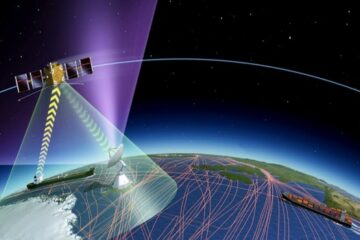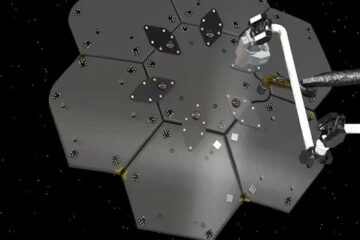Introduction
Startups in the aerospace sector play a crucial role in fostering competition, addressing new challenges in space exploration, satellite technology, urban air mobility, and beyond. The startups proposed in this article represent the vanguard of innovation in their respective fields stimulating in this way economic growth and promoting a continuous progress within the aerospace landscape.
Volocopter
Founded in 2011 by Alexander Zosel and Stephan Wolf in Germany, Volocopter is a prominent player in the eVTOL sector that has garnered attention for its advancements in designing aerial vehicles capable of navigating urban landscapes seamlessly.
Urban areas worldwide face challenges that impede the smooth flow of transportation. Traffic congestion, resulting in delays and increased travel times, not only reduced productivity but also diminished the quality of life for city dwellers. Limited infrastructures exacerbate these issues, leaving urban transportation struggling to meet the demands of a growing population. Furthermore, the environmental impact of urban transport, marked by air pollution and greenhouse gas emissions, underscores the urgent need for transformative solutions.
Urban Air Mobility has emerged as a solution to these urban mobility challenges. The concept envisions leveraging the airspace above cities for efficient and rapid transportation, providing an alternative mode of travel that overcomes the limitations of traditional infrastructures. Central to this transformative vision are electric vertical takeoff and landing (eVTOL) aircrafts, and Volocopter stands as a pioneer in this field.
By introducing eVTOL aircraft, the company seeks to offer a seamless and sustainable mode of transportation that bypasses ground-level obstacles. This innovative approach has the potential to reduce traffic congestion and travel times, enhance productivity, as well as mitigate the environmental impact associated with conventional urban transport. The three most important eVTOL aircrafts are: Volocity (air taxi), VoloRegion (long-haul passenger aircraft) and VoloDrone (heavy-lift cargo drone).
The VoloCity air taxi is built to operate in the lower airspace with a near-silent and emission-free profile, in order to facilitate passenger transport between crucial transportation nodes such as train stations and airports. Its streamlined design, advanced architectural features, and adept integration of cutting-edge technologies contribute to a vision aimed at enhancing the convenience and sustainability of urban life on a significant scale. It is composed by 2 seats, 18 rotors and it can reach the maximum speed of 110 km/h in order to cover a distance of 35 km. It is crafted to adhere to the rigorous aviation standards and regulations established by the European Aviation Safety Agency (EASA), the groundbreaking VoloCity design has successfully secured Design Organization Approval (DOA).

The commercial launch is scheduled to coincide with the 2024 Olympic Games in Paris. Selecting Paris as the launch location is a strategic and sensible decision for Volocopter. As a densely populated capital facing challenges in its public transportation infrastructure, Paris is in urgent need of innovative solutions. Additionally, being a famous tourist destination, the city experiences a notable surge in population during peak travel seasons. This aligns with Volocopter’s goal to address urban congestion and provide efficient transportation alternatives, making Paris an ideal setting for the commercial launch.
A partnership has been established with key public transportation authorities in Paris, namely Groupe ADP (Aéroports de Paris) and RATP (the city’s public transit operator and one of the nation’s largest transportation organizations). Over the past 3 tears, close collaboration has been maintained with both ADP and RATP to actualize plans for electric air taxis. This collaborative effort has set the stage for a two-year trial phase, encompassing test flights, route mapping, and coordination with these and other French authorities. The trial phase serves as a crucial preparatory step, allowing for the initiation of small-scale operations. Moreover, it provides an opportunity to mature valuable experience and feedback from both authorities and partners, contributing to the continual enhancement of operational efficiency.

Impulse Space
Established in September 2021 by Tom Mueller, a founding member of SpaceX, Impulse Space operates as a Space 2.0 payload delivery company with a focus on developing orbital maneuvering vehicles tailored for last-mile payload delivery. Payloads include scientific or technological instruments carried on board, serving various purposes such as communication, earth observation, navigation, scientific research, human support, and cargo transportation. One significant advantage of payloads lies in their data collection capabilities. Impulse Space’s vehicles are designed to transport multiple payloads to distinct orbits within a single launch.
Currently, the company is actively engaged in the development of two key products: Mira and Helios. Mira is optimized for Low Earth Orbit (LEO) Express services, offering last-mile delivery to any orbit in LEO (altitudes ranging between 300 and 1000 km). Clients, typically companies, have the flexibility to select the altitude and inclination with controlled atmospheric re-entry. Mira’s performance depends on the payload it accommodates, and it is estimated to provide approximately 600 meters per second of delta-v with a 300-kilogram payload—exceeding the payload capacity of competitors with comparable delta-v. Mira employs ethane and nitrous oxide as propellants, both environmentally friendly and non-toxic. The company successfully launched its inaugural orbital transfer vehicle on a SpaceX Falcon 9 rideshare mission, transporting a primary payload for an undisclosed customer. Subsequent LEO Express missions are scheduled to launch on SpaceX Transporter rideshare missions in 2024. Helios is currently undergoing development and serves as an expanded version of Mira, emphasizing its application in Geostationary Earth Orbit (GEO).
Impulse Space has created a strategic partnership with Relativity, a pioneer in 3D printing entire rockets, aiming to achieve the first commercial landing on Mars. Their collaborative effort involves deploying the Mars Lander into freefall in 2026, marking the inaugural commercial payload delivery to another planet’s surface.

As a startup, Impulse Space has demonstrated remarkable achievements over the past year, securing a substantial $75 million in funding. This includes a $45 million Series A funding round led by RTX Ventures and a $30 million seed funding round, with $20 million from Founders Fund and $10 million from Lux Capital. The company’s aim is to leverage Starship’s transformative rideshare capabilities and actively participate in the evolving lunar economy, positioning themselves as market leaders. Noteworthy distinctions include their innovative potential to reshape the space transportation landscape and a vertically-integrated company structure, fostering stringent cost control—an attribute inherited from CEO Tom Mueller’s 17 years of experience at SpaceX.
Relativity Space
Founded in 2015 by Tim Ellis and Jordan Noone in California, Relativity Space emerges as a revolutionary startup that is radically changing traditional approaches to rocket design, manufacturing, and launch services. The company’s strategy revolves around the use of 3D printing technologies, allowing them to bypass traditional manufacturing steps and produce entire rocket components as single designed pieces. This approach not only simplify the manufacturing process but also provides the flexibility of design and rapid prototyping capabilities.
At the forefront of Relativity Space’s innovative endeavors is the Terran 1 rocket, a spacecraft partially (90%) composed of 3D-printed components. Launched in 2023, Terran 1 consisted of two stages: the first stage is powered by nine Aeon 1 engines (Relativity’s in-house propulsion system) and the second stage is powered by a single vacuum-optimized version of Aeon 1. Relativity Space asserts a staggering 100-fold reduction in part count compared to conventionally manufactured rockets, emphasizing the efficiency of their 3D printing approach, resulting in shorter production timelines and heightened cost-effectiveness.

Following the triumph of Terran 1, Relativity Space identified a market need for swift and cost-effective satellite launches, prompting the development of Terran R. As a heavy-lift two-stage vehicle partially constructed using 3D printing, Terran R embodies reusability as a core design principle. The construction of Terra R aims to enhance cost-effectiveness, aligning with the company’s sustainability goals. Moreover, Terran R is expected to offer a higher payload capacity compared to its predecessor, addressing the demand for heavier payloads in space missions.
Relativity Space has achieved notable success, including functional test flights and strategic partnerships within the aerospace industry, solidifying its reputation as a trailblazer in the New Space Economy. With ambitious plans for expansion and ongoing projects like Terran R targeting emerging space markets, Relativity Space is poised to play a pivotal role in shaping the future of space exploration.
SpinLaunch
Founded in 2014 by Jonathan Yaney in California, SpinLaunch is a cutting-edge aerospace company committed to redefining the conventional approach to space launch. At the heart of SpinLaunch’s innovation is a revolutionary concept that challenges traditional rocket launch methods. Unlike traditional rockets that rely on chemical propulsion, SpinLaunch utilizes a unique kinetic launch system to catapult payloads into space, reducing the reliance on conventional rocket fuel.
In order to understand SpinLaunch’s work it is necessary to explain the problem that SpinLaunch is trying to solve thanks to the rocket equation. The rocket equation serves as a fundamental framework for describing the motion of a rocket during its departure from Earth and its subsequent journey to Low Earth Orbit (LEO). Initially, upon departure from Earth, the rocket possesses a velocity of zero. To ascend and increase its distance from the Earth’s surface, the rocket must continually augment its velocity. As the rocket moves farther from Earth, the potential energy resulting from gravity elevates, necessitating a greater Illustration of the Rocket Equation velocity to sustain the rocket’s trajectory. Equation 1 establishes the interdependence between this required velocity variation and the change in the mass of the rocket. Upon closer examination of the equation’s terms, it becomes apparent that the mass lost by the rocket must be nearly equivalent to its initial mass. Given that the primary component of mass lost during the rocket’s journey is fuel, it follows that approximately 90% of a rocket’s mass must be composed of fuel. This composition constraint imposes limitations on the payload capacity of a single rocket, resulting in substantial costs associated with the required fuel.

To address the challenge of high launch costs, SpinLaunch has developed a unique catapult system designed to accelerate rockets and propel them into space. In this innovative approach, the rocket experiences an initial high velocity that gradually decreases over time, allowing it to achieve a height of 72 km solely through kinetic energy. One of SpinLaunch’s groundbreaking innovations is its launcher, a massive cylindrical chamber maintained under vacuum conditions. Within this chamber, a rapidly rotating tether, attached to the rocket, propels the vehicle into space. The vacuum environment minimizes friction between the rotating tether and the air, preventing heating and potential fusion of materials in the tether and the rocket. The rocket is initially released with a velocity of 2000 m/s, reaching an altitude of 72 km. Subsequently, the rocket sheds its aero shell, further increasing velocity. At 250 meters in altitude, the rocket undergoes another separation, activating a motor with additional fuel to propel the rocket to Low Earth Orbit (LEO) at 500km.
SpinLaunch’s ambitious project gained credibility over time, attracting substantial investments from prominent backers such as Google Ventures and Airbus Ventures. The demonstrated results have strengthened confidence in the company’s approach to space launch. SpinLaunch’s goal is to achieve a launch cost of $2500 per kilogram, positioning themselves as one of the most cost-effective satellite transportation providers. The key to achieving this low cost lies in the efficient use of electricity during launches, with an estimated expenditure of around 100 MWhr per launch, translating to a cost of approximately $6000. The utilization of a reusable launcher further contributes to cost-effectiveness. Additionally, SpinLaunch aspires to establish a high-frequency launch system, aiming to launch approximately 10 rockets per day. This multifaceted strategy positions SpinLaunch as a transformative player in the space launch industry.

Yet, they have been able to build a Lab and a Suborbital facility, that is a small sized launcher, with a diameter of 33 meters, 1/3 of the size of the envision Orbital launcher, and they have already completed 10 test launches. Their physics perfectly checks out, and if you are more curious I can suggest to watch Real Engineering video that talks about their engineering challenges in detail. Thanks to their credibility they were also nominated one of the 100 most influential companies by time in 2022.
Written by Chiara Nespoli, Leopoldo Schiavi, Luis Pericchi, Benedetta Zanini



0 Comments